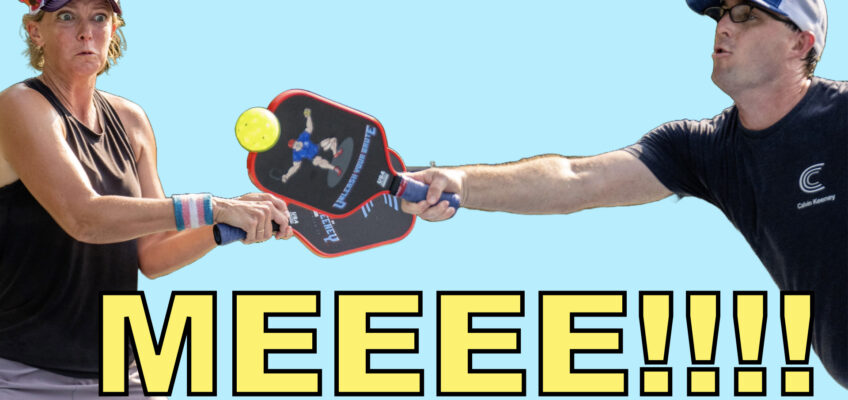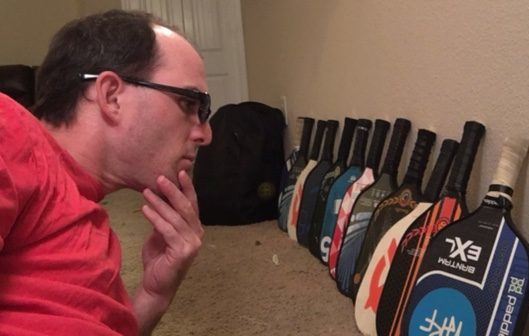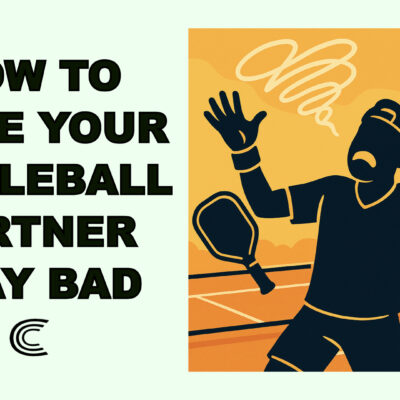If you’ve ever asked yourself, “Who should take the middle ball in doubles pickleball?”—you’re not alone. As a coach, I get this question all the time, especially from players preparing for tournaments or jumping into rec games with new partners.
You’ve probably heard the phrase “forehand takes the middle”. While that’s a decent starting point, it doesn’t always hold up—especially when the pressure is on or when you’re playing with mixed-handed partners. In this post, we’ll break down who should take the middle ball in two key situations: when your team is being attacked and when your team is on the attack.
1. When Your Team Is Being Attacked
Let’s say your opponents drive the ball hard between you and your partner. This is an attack, and you won’t have time to yell “mine” or “yours.” So, how do you decide who takes the shot?
Here’s the rule I teach:
- The player directly in front of the driver should protect their sideline and as much of the middle as they can.
- The other player should help by covering just beyond their partner’s “bubble” (reach zone).
This helps you cover more court as a team without colliding paddles. If both players reach for the same ball and crash, the blame usually falls on the player farther from the opponent (think: like a car accident—the car behind is typically at fault). So give the player closest to the drive the right to reach confidently.
Positioning matters here. If you’re the diagonal partner, make sure you’re close enough to help, but not so close that you risk paddle clashes. Cover what’s just beyond your partner’s reach.
(Also Read: Great Pickleball Ready Position Tips)
2. When Your Team Gets a High, Slow Ball
Now let’s flip the situation. You or your partner just hit a good shot, and your opponent pops it up in the middle. This is no longer a scramble to defend—it’s your chance to attack.
This is where the “forehand takes the middle” advice is more useful, especially if you and your partner are both right-handed. In most cases:
- The forehand-side player should aggressively take high, slow balls in the middle—even if they need to reach over slightly.
- The backhand-side partner should concede and give space for a full, confident forehand slam.
But there are exceptions. Maybe your partner has a stronger or more reliable backhand overhead. If that’s the case, then your team should set a default plan before the match. For example, agree that if your partner is on the left and the ball floats middle, they should take it—even if it’s not a forehand.
I know this isn’t always practical in open play, but should help with partners you play with often.
3. Have Defaults in Place with Your Pickleball Partner
The best doubles teams communicate before the game/point. You won’t always have time during a rally to talk. That’s why I recommend agreeing on these defaults:
- When defending a drive: both players protect their zones, and the player closer to the driver has the right to reach.
- When attacking a popup: the stronger hitter (usually forehand) should take priority, and their partner should concede.
Defaults like this help avoid confusion and give players confidence to go after the right balls.
(Also Read: Pickleball Nets: Which Portable One is Best for You)
Final Thoughts
The answer to “who should take the middle ball?” isn’t always simple. It depends on:
- Whether you’re attacking or defending
- Your team’s handedness (right vs. left)
- Who has the stronger shot in that situation
Forget the one-size-fits-all answer. If you’re being attacked, both players should defend their territory as best they can. If you’re given a high ball to slam, have a plan ahead of time for who’s taking it. Prioritize clear defaults and trust in your teamwork.
Want to Read More Pickleball Posts?









Leave a Reply
You must be logged in to post a comment.